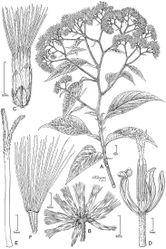Cuatrecasanthus lanceolatus
| Notice: | This page is derived from the original publication listed below, whose author(s) should always be credited. Further contributors may edit and improve the content of this page and, consequently, need to be credited as well (see page history). Any assessment of factual correctness requires a careful review of the original article as well as of subsequent contributions.
If you are uncertain whether your planned contribution is correct or not, we suggest that you use the associated discussion page instead of editing the page directly. This page should be cited as follows (rationale):
Citation formats to copy and paste
BibTeX: @article{Robinson2012PhytoKeys14, RIS/ Endnote: TY - JOUR Wikipedia/ Citizendium: <ref name="Robinson2012PhytoKeys14">{{Citation See also the citation download page at the journal. |
Ordo: Asterales
Familia: Asteraceae
Genus: Cuatrecasanthus
Name
Cuatrecasanthus lanceolatus H. Rob. & V.A. Funk sp. nov. – Wikispecies link – IPNI link – Pensoft Profile
Type
Ecuador. Zamora-Chinchipe:Loja–Zamora, km 20.6, 03°57'S, 79°05'W, 2650 m, 9 August 1997, G.P.Lewis 3424 (holotype: US!; isotypes: AAU!, GB, K, LOJA, MO, QCA, QCNE).
Description
Shrubs to small trees up to 2 m high; stems flexuous above, hexagonal, densely pilose with brownish trichomes. Leaves with petioles mostly 0.5–1.5 cm long; blades lanceolate, broadest at basal 1/3, 4.0–9.5 cm long, 1–3 cm wide, apex distally narrowly acute, not acuminate, margins not or scarcely recurved distally, with marginal teeth projecting upward or outward (may vary in intensity), not inward, adaxial surface dark green, lamina dotted with gland-like persistent or aborted stumps of small scaber, with weakly insculpate veins, abaxial surface gray-green, tawny-pilose, sometimes contorted, denser on veins, with thin grayish prostrate myceliiform branching trichomes; secondary veins in 4–5 pairs, strongly ascending. Inflorescence distinctly exceeding the reduced distal leaves, main axis and branches mostly deflected at nodes, rounded corymbiform; branches tomentellous. Heads sessile in clusters of 2–6 congested in larger dense glomerules, 10–11 mm high × 2 mm wide; involucres cylindrical or fusiform, ca. 16 in ca. 5 series, 1.0–4.5 mm long, ca. 1.2 mm wide, short-acute, greenish brown, darkened at tips or along midvein distally, glabrous. Florets with corollas pink-lilac, ca. 6 mm long, with numerous glandular dots on basal tubes, with a few short hairs at apices of tubes, tubes ca. 2 mm long, lobes ca. 4 mm long; anther thecae dark reddish brown, ca. 2.5 mm long. Achenes ca. 2 mm long; pappus white, of ca. 45 capillary bristles ca. 6.5 mm long, not or scarcely broadened at tips. Pollen grains ca. 35 µm in diam.
Additional specimens examined
Ecuador. Loja: Road to Zamora from Loja, km 12–14, near top of pass, [03°59'6"S, 79°08'23"W, estimated], 2800 m, 28 September 1961, Dodson & Thien 781 (US-2!).
Habitat
Local in secondary scrub at 2650–2800 m in elevation (Fig. 10).
Preliminary conservation status
Data Deficient
Original Description
- Robinson, H; Funk, V; 2012: Cuatrecasanthus (Vernonieae, Compositae): A revision of a north-central Andean genus PhytoKeys, 14: 23-41. doi
Images
|


